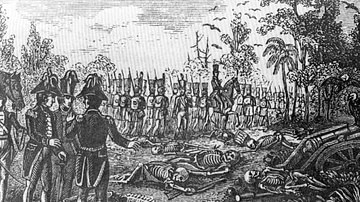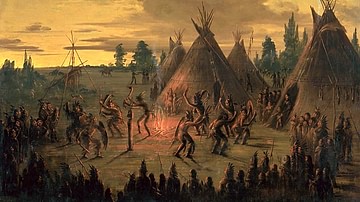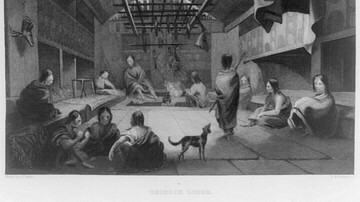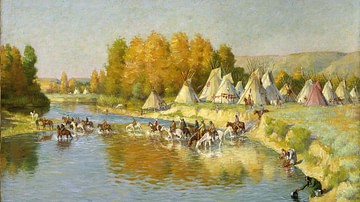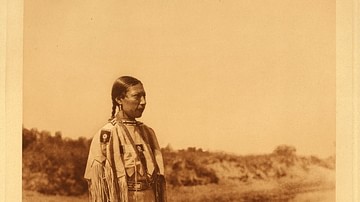The Seminole are a Native American nation of people descended from the Muscogee Creek nation, and others, who migrated to the modern-day State of Florida in the 1700s fleeing wars in the north. They were later joined by runaway slaves known as Black Seminoles. A Seminole Creation Story is one version of many creation tales of the people.
Their name, Seminole, comes from either the Creek word for "runaway" or "outcast" or a corruption of the Spanish word cimarones for "untamed" or "wild." The Seminole people refer to themselves as Yat'siminoli ("free people") also translated as "The Unconquered People" as they resisted the theft of their lands and forced relocation by the US government. The Florida Seminoles refused to surrender during or after the Seminole Wars (1816-1858).
During the Second Seminole War (1835-1842), the Seminoles were led by Osceola (l. 1804-1838), John Horse (Jean Caballao, l. c. 1812-1882), and others. Some of these bands surrendered in hopes of finding freedom in the West. Today, the Seminole Tribe of Florida, the Miccosukee Tribe of Indians of Florida, and the Seminole Nation of Oklahoma are federally recognized tribes of the Seminole Nation.
Seminole spirituality is deeply rooted in the natural world and the land they know as their own. Their legends and lore frequently feature the region of the modern-day State of Florida as the setting for interactions between the mortal and higher realms. The three stories below, however, among their best-known, focus on the creation of the world, the path back to the Creator, and how the people came to live as they do.
Text
The following tales are taken from the Legends of the Seminoles page of the Seminole Tribe of Florida (A Creation Story), Voices of the Winds: Native American Legends (2021) by Margot Edmonds and Ella Clark (The Milky Way), and Seminole Indian Legends, compiled by workers of the Writer's Program of the Works Projects Administration in the State of Florida, 1940 (The Morning Star).
A Creation Story
When the Creator, the Grandfather of all things, created the earth, there were many things he wanted to put there. Birds, animals, reptiles, insects, and many different living things. The Creator did have certain favorite animals. He liked the Panther – Coo-wah-Chobee – crawls on four legs, close to the ground. The Panther would sit beside the Creator, and He would pet the Panther, over and over, across its long, soft, furry back.
The Creator made sure that certain animals and plants possessed unique healing powers. When the Creator touches certain things longer than normal, His powers automatically go into what He touches. He told Panther, "When it's complete, I would like for you to be the first to walk on the earth. You are majestic and beautiful. You have patience and strength. There is something special about you. You are the perfect one to walk the earth first."
Creator went to work making all sorts of animals and birds. Animals on all fours, animals with hooves, animals with paws, birds with claws, insects, reptiles - why, there was nothing the Creator left out. When the earth was ready, Creator put all the animals in a large shell. He set it along the backbone of the earth - the real high mountains. "When the timing is right," He told the animals, "The shell will open and you will all crawl out. Someone or something will crack the shell and you must all take your respective places on the face the earth." The Creator then sealed up the shell and left, hoping the Panther would be first to come out.
Time went along, and nothing happened. Alongside the shell stood a great tree. As time passed, the tree grew so large that its roots started encircling the shell. Eventually a root cracked the shell. The Panther was patient, which the Creator liked. But, at this particular time, Panther was too patient. The Wind started circling around the crack in the shell, round and round the inside, so vigorously that the crack was made larger.
The Wind, however, remembered that the Creator wished for the Panther to be on earth first. "We will fulfill the Creator's wishes," said the Wind, reaching down to help the Panther take its place on earth.
The Wind was everywhere. The Wind was the air we breathe. After Wind helped the Panther out first, the Panther thanked Wind for the honor. Next to crawl out was the Bird. The Bird had picked and picked around the hole, and, when the time was right, stepped outside the shell. Bird took flight immediately. After that, other animals emerged in different sequences. Bear, Deer, Snake, Frog, Otter. There were thousands of others, so many that no one besides the Creator could even begin to count them all. All went out to seek their proper places on earth.
Meanwhile, as Bird was flying around looking for a place to live on earth, the Creator was watching. He watched each animal and did not intervene, but left the animals on their own. The Creator often allows things to happen along their own sequences. Sometimes a thing must happen on its own merits.
When the Creator saw that all was done, He decided to name the animals and put them into Clans. For being such a good companion, the Creator rewarded the Panther with special qualities: "Your Clan will have the knowledge for making laws and for making the medicine which heals," Creator told Panther. "You, the Panther, will be in possession of all knowledge of different things. The Panther will have the power to heal different ailments and to enhance mental powers."
Creator believed the actions of the Wind were very honorable and noble, so He told the Wind: "You will serve all living things so they may breathe. Without the wind - or air - all will die."
The Bird, for being able to take flight, will be ruler of the earth, said the Creator: "The Bird will make sure that all things are put in their proper places on earth."
So, this is how the beginning was made. Some call it the Creation. Though there were many, many animals put on this earth by the Creator, all came to know their proper places on earth…
Stories such as the Creation and many other legends do have important meanings to us. Sometimes, however, interpreting them may confuse us. Seminole, Miccosukee, Creek, Cherokee, Choctaw, and many other tribes tell tales of Creation. These stories may or from Clan to Clan. For good reason - they all live in different locations on the earth and that has much to do with the way the stories are told.
The Milky Way
Ever so long ago, the Breathmaker blew his breath toward the sky and created the Milky Way. This broad pathway in the night sky leads to the City of the West. There is where the souls of good Indians go when they die.
Bad Indian souls stay in the ground where they are buried. When the Seminole Indians walk through the woods and step where a bad person has been buried, they become fearful. Even though the grave is covered with brush, they always seem to know that a bad person is buried there.
The Seminoles say the Milky Way shines brightest following the death of one of their tribe. They believe this is so that the path to the City in the Sky will be lighted brightly for the travelling Seminole.
For a good Indian to be able to walk over the Milky Way, he must first be one whom everyone likes. He cannot be one who talks in an evil manner or lies and steals. He must be brave at all times and an honor to the Seminoles.
In the Seminole language, so-lo-pi he-ni means "spirit way" or "the Milky Way for human souls." And if-i he-ni means "dog way" and is the sky-path for the souls of dogs and other animals that die. Spirits never return to earth from the City in the Sky. Seminoles do not believe that ghostly visitors ever come back and visit their people again.
Along the Milky Way lives Rain and Rainbow. The Seminole word for Rainbow means stop-the-rain, and that is what the Rainbow does when it appears.
When the Sun is eclipsed, Seminoles say that toad-frog has come along and taken a bite out of the Sun. Toad-frog continues eating at the Sun until the Sun disappears. Seminole hunters shoot arrows at toad-frogs whenever they see one, preventing eclipses of the Sun or Moon. Seminole hunters like to make a loud clamor to scare the toad-frogs away when they do appear.
Along the Milky Way is Big Dipper, which seems like a boat to the Seminoles. They say it is used to carry the souls of good Seminoles along the Milky Way to the City in the Sky. The Seminole tribe calls the Morning Star the Tomorrow Star, and the Evening Star is known to them as the Red Star.
The Morning Star
Chok-fee, an Indian lad, lived with his grandmother in a great cypress
forest. Chok-fee spent a great deal of his time hunting and making good, straight arrows. When he was a little boy, his grandmother told him that a young man's part in life was to be a good warrior and hunter. To accomplish this, he must be able to shoot straight and be a swift runner. Chok-fee grew to be a tall man and was the swiftest runner and best marksman in his tribe.
When Chok-fee was young grandmother would not allow him to hunt far from home, but as he grew older, he ventured father and father into the forest. One morning, as he set eating breakfast, his grandmother said to him:
"Now, my dear grandson, you are a grown man, and you are going to be covering more and more territory in your hunting trips. That is very good, but, Chok-fee, my grandson, be careful that in wandering through the great forest you do not go two days journey towards the south. I am warning you, my grandson, you must not go that way. If you do great misfortune will befall you and you may never come back. When you go hunting, you must go east, north, or west. There are many deer and turkeys there, but do not go south."
After finishing his breakfast, Chok-fee secured his bows and arrows and started out. As he traveled, he wondered why his grandmother had told him not to travel south. The farther he traveled, the more curious he became, until finally he decided to do what his grandmother had warned him not to do. He traveled southward all day, not killing any game, although there were numerous deer and turkeys. The next morning, he continued his trip to the south.
After a time, he saw some big deer tracks, all leading southward. He followed the trail, and finally came to the end. Deep in a jungle-like forest were two lodges, a large one and a small one, but the trail led to the large one. As he stood at the door, wondering if this was the place about which his grandmother had warned him, a man's gruff voice spoke from within the lodge. "My dear friend, do not stand outside wondering if it would not be safe to come in. Come right in, my friend, nothing will hurt you. I am home alone."
Chok-fee entered and sat down near the door. The old man sat at the other end of the lodge, covered so that his head was hidden. Chok-fee was hungry, so the old man ordered food for him. When he had finished eating, he asked the man if there was anything he could do for him, in return for the food. The old man told him to go to bed, and on the morrow, he would tell him why he had come to this place.
When Chok-fee awoke the next morning, the sun was rising. The man still had not uncovered his head. He spoke to Chok-fee, "My friend, I am the one who made you come here. Your grandmother was right in telling you not to come, but I made you come here, because I need your help. This is the last day." So saying, the man removed the cover, and Chok-fee observed that he had no head:
The man explained to Chok-fee that four days ago, an Unga, a very large bird with a face like a man, came and cut off his head. When Chok-fee asked why, the man said that the Unga wanted to marry his daughter, Wah-see-get, and when he refused his permission, the Unga cut off his head. If, at the end of the fourth day, the man had not changed his mind, he would not live anymore and the Unga would take his daughter away.
When Chok-fee offered to help, the man told him to go to the big cypress tree that almost touched the sky, and there he would find the Unga. Chok-fee must kill the Unga by shooting him in the heart and bring the man's head back to him by mid-day. Otherwise, the man would die. Chok-fee took his bow and arrows and followed the directions the old man had given him. Just before noon, he reached the tall cypress tree and found the Unga holding the man�s head in his hands. The head had beautiful red hair.
There were two birds, and one of them flew towards Chok-fee, dropping a big snake which failed to hit him. Chok-fee shot it down and, as he did so, the other bird flew at him. Again Chok-fee shot, with the same result.
At this time the head spoke and said, "You have done well, my friend, but you have to kill the Unga when he flies to attack or else both of us will die. He will not let me go unless you kill him. And you must hit him in the heart if you want to kill him. When you kill him, you must pick me up and hurry me home because, after mid-day, I will not live if I don't get back.
Just at this moment the Unga flew toward Chok-fee still carrying the head. As the bird swooped down, Chok-fee took a shot at him but missed. The bird did this three times and, each time, Chok-fee shot but always missed. On the third time the bird came so near Chok-fee that he was knocked down by the Unga�s wings. As the bird attacked him the fourth time, Chok-fee�s fourth arrow, pierced the Unga�s heart, and it fell dead to the ground.
Picking up the head, which the bird had dropped nearby, Chok-fee ran for the ledge, as it was very near mid-day. In order to save time, he threw the head to the man, as he came near the door. The man caught it and placed it on his shoulders, one minute before mid-day.
"Well done," said the man, and invited Chok-fee into the lodge. "My friend," he said, "You have saved my life and saved your people by killing the bad bird, and for your reward everything that belongs to me is yours, but, my friend, do not enter that other lodge for four days after I leave. My beautiful daughter lives there and she is going to be your wife. That is part of your reward for your brave deed but remember what I say. If you do not look inside for four days after I leave, you will accomplish a lot for your people. You will never have to hunt. You will never go hungry, and you will have everything you want by just wishing for it. All the deer in the land are yours now. They all belong to you and that is the reason the deer trail leads to this lodge."
The man prepared to go, dressing himself in red and carrying a red bow and arrow. Again, warning the boy not to go to the other lodge for four days, he walked skyward. He went higher and higher until there was nothing but a red spot in the sky. Even to this day it can be seen, the only red star in the sky. It is the Indian with the beautiful red hair.
Curiosity overcame Chok-fee and, at the end of the third day, he peeped into the small lodge. There he saw a beautiful girl dressed in white doeskin. He entered and stood staring at her. The light became brighter and brighter, until he was blinded by it. When he could see again, there was no sign of the lodge, only a vast swampland. The girl had risen to the sky in the blinding light and had become the bright morning star.
If Chok-fee had waited four days to enter the lodge, as the legend goes, to this day the Indians would have everything they want, only by wishing for it. Instead, they have to walk miles and miles to get deer to eat.


